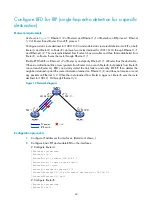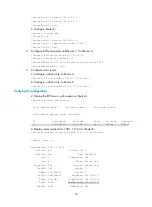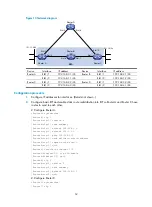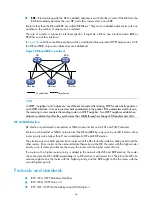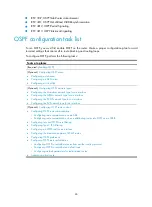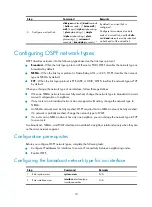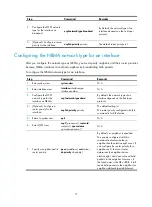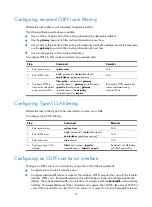
59
LSA types
OSPF advertises routing information in Link State Advertisements (LSAs). The following LSAs are
commonly used:
•
Router LSA
—Type-1 LSA, originated by all routers and flooded throughout a single area only. This
LSA describes the collected states of the router's interfaces to an area.
•
Network LSA
—Type-2 LSA, originated for broadcast and NBMA networks by the designated router,
and flooded throughout a single area only. This LSA contains the list of routers connected to the
network.
•
Network Summary LSA
—Type-3 LSA, originated by Area Border Routers (ABRs), and flooded
throughout the LSA's associated area. Each summary-LSA describes a route to a destination outside
the area, yet still inside the AS (an inter-area route).
•
ASBR Summary LSA
—Type-4 LSA, originated by ABRs and flooded throughout the LSA's
associated area. Type 4 summary-LSAs describe routes to Autonomous System Boundary Router
(ASBR).
•
AS External LSA
—Type-5 LSA, originated by ASBRs, and flooded throughout the AS (except stub
and NSSA areas). Each AS-external-LSA describes a route to another AS.
•
NSSA LSA
—Type-7 LSA, as defined in RFC 1587, originated by ASBRs in NSSAs and flooded
throughout a single NSSA. NSSA LSAs describe routes to other ASs.
•
Opaque LSA
—A proposed type of LSA. Its format consists of a standard LSA header and
application specific information. Opaque LSAs are used by the OSPF protocol or by some
applications to distribute information into the OSPF routing domain. The opaque LSA includes Type
9, Type 10, and Type 11. The Type 9 opaque LSA is flooded into the local subnet, the Type 10 is
flooded into the local area, and the Type 11 is flooded throughout the AS.
OSPF areas
In large OSPF routing domains, SPF route computations consume too many storage and CPU resources,
and enormous OSPF packets generated for route synchronization occupy excessive bandwidth.
To resolve these issues, OSPF splits an AS into multiple areas. Each area is identified by an area ID. The
boundaries between areas are routers rather than links. A network segment (or a link) can only reside in
one area as shown in
.
You can configure route summarization on ABRs to reduce the number of LSAs advertised to other areas
and minimize the effect of topology changes.





